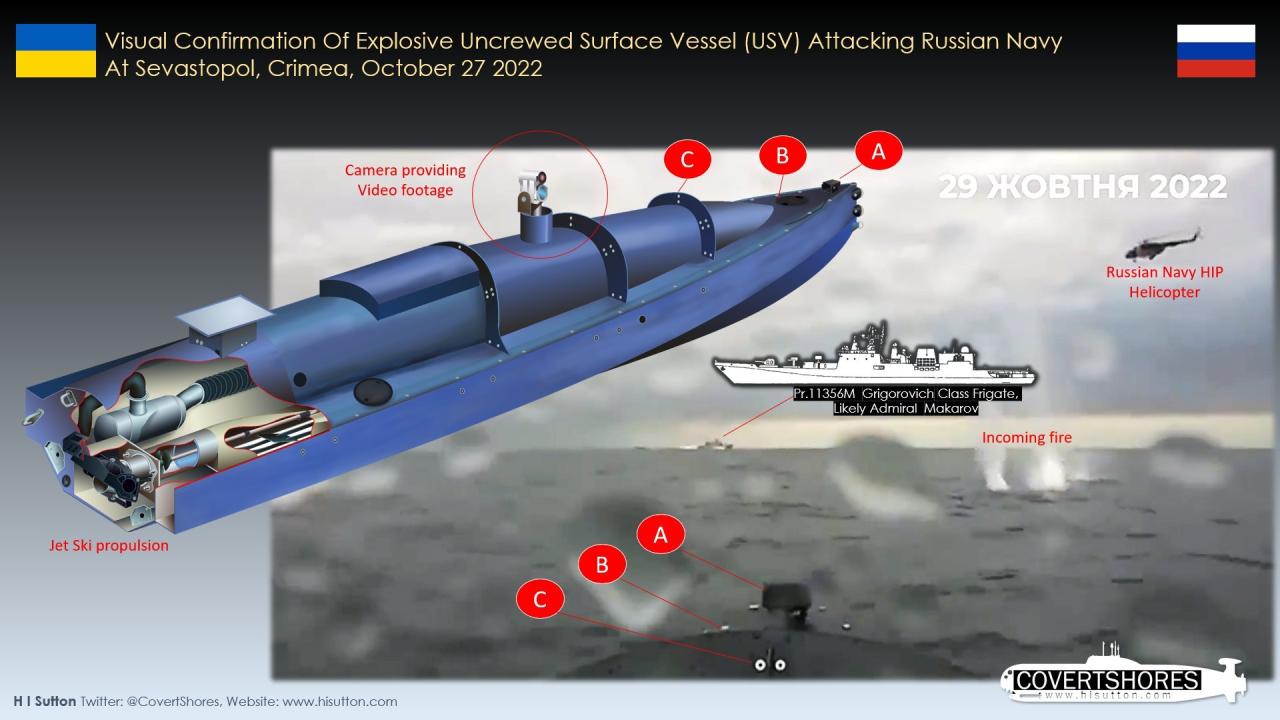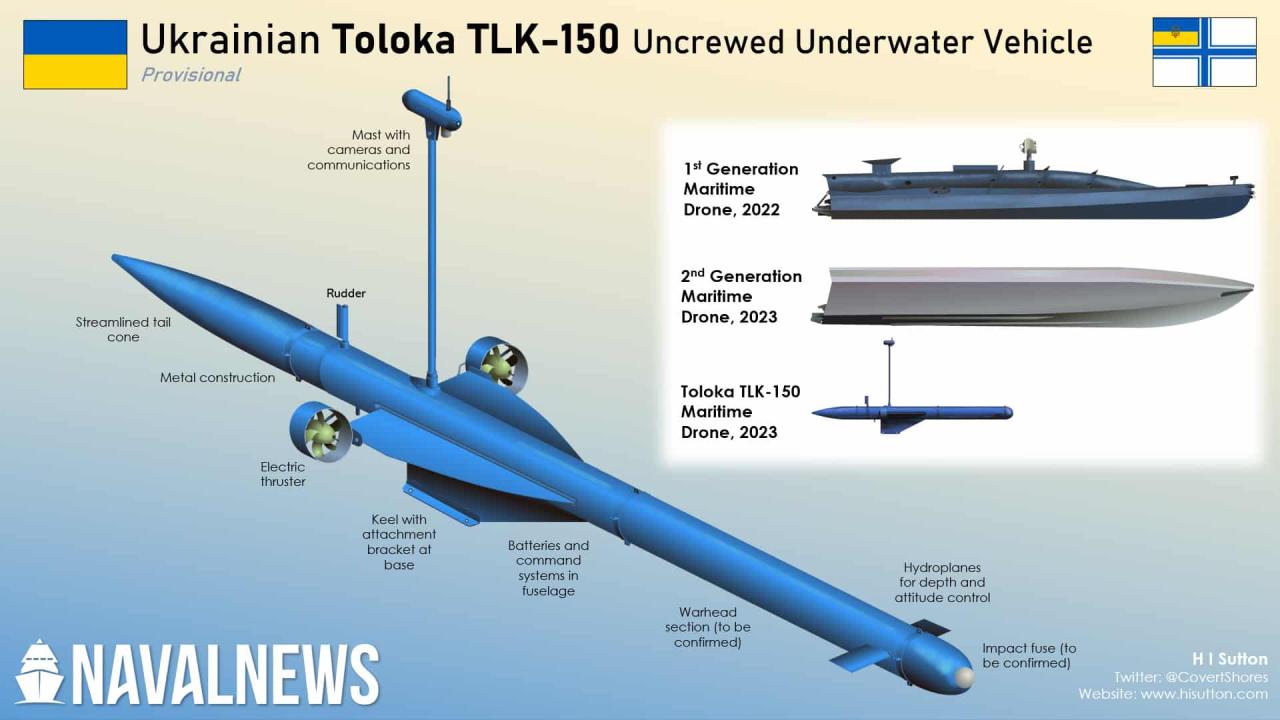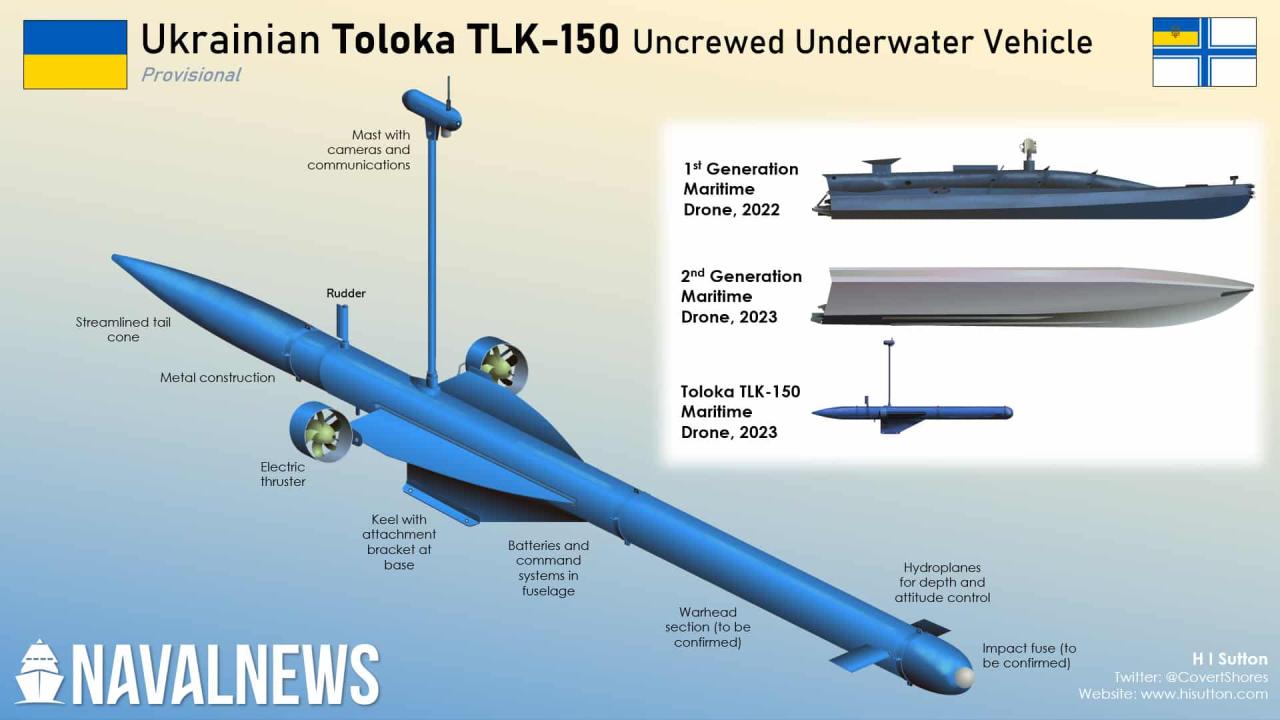Ukrainian sea drones are rapidly changing naval warfare. These unmanned vessels, packing surprising firepower and sophisticated technology, are proving highly effective in asymmetric conflicts. Their relatively low cost, combined with their ability to inflict significant damage on larger, more expensive targets, makes them a game-changer. This exploration delves into their technical capabilities, deployment strategies, and broader geopolitical implications.
From their design and construction to their operational use and future development, we’ll examine the impact of these drones on naval strategy and the global arms race. We’ll also look at the technological advancements driving their evolution and consider the ethical questions raised by their increasing autonomy.
Ukrainian Sea Drones: A Technological Deep Dive
Ukraine’s innovative use of unmanned surface vessels (USVs), commonly referred to as sea drones, has significantly impacted modern naval warfare. These relatively inexpensive and adaptable systems have proven surprisingly effective against larger, more expensive naval assets. This article delves into the technical specifications, operational capabilities, impact, and future potential of these game-changing naval platforms.
Ukrainian Sea Drone Types and Technical Specifications

Several types of Ukrainian sea drones are currently in operation, each designed for specific missions. These range from smaller, simpler designs for coastal patrol and reconnaissance to larger, more sophisticated models capable of carrying heavier payloads and operating over longer distances. Propulsion systems vary, but generally utilize electric motors powered by batteries, offering quiet operation and stealth capabilities. While precise specifications are often kept confidential for security reasons, publicly available information suggests a range of capabilities.
| Drone Model | Speed (knots) | Range (nautical miles) | Payload Capacity (kg) |
|---|---|---|---|
| Model A (Hypothetical Example 1) | 15-20 | 50-100 | 100-200 |
| Model B (Hypothetical Example 2) | 10-15 | 150-250 | 300-500 |
| Model C (Hypothetical Example 3) | 25-30 | 25-50 | 50-100 |
Compared to other nations’ sea drone technologies, Ukrainian designs demonstrate a notable emphasis on cost-effectiveness and adaptability, often leveraging commercially available components and readily available materials. While perhaps not possessing the advanced sensor suites or autonomous capabilities of some Western counterparts, their simplicity and effectiveness in asymmetric warfare make them a significant force multiplier.
Deployment and Operational Strategies

Deployment methods for Ukrainian sea drones are varied and often depend on the specific mission and operational environment. Methods include launching from larger vessels, smaller boats, or even directly from the shore. Targeting and navigation rely on a combination of GPS, inertial navigation systems, and potentially other sensor inputs, depending on the model. Communication systems likely utilize secure, encrypted links to maintain control and receive data from the drones.
Ukrainian sea drones are making waves in naval warfare, showcasing impressive autonomous capabilities. It’s a far cry from the dazzling spectacle of a drone show, like the amazing shanghai dragon drone show , but both highlight the rapidly evolving technology behind unmanned aerial vehicles. The precision and coordination needed for both military applications and large-scale entertainment displays are surprisingly similar.
Ultimately, Ukrainian sea drones and the Shanghai show demonstrate different facets of drone innovation.
The effectiveness of these drones is demonstrably high in coastal waters, but their range and endurance also allow for operations in more open ocean environments, though with limitations.
A typical deployment sequence might involve:
- Pre-mission planning and target acquisition.
- Drone preparation and payload loading.
- Deployment from a designated platform.
- Navigation to the target area using pre-programmed coordinates or real-time guidance.
- Execution of the mission (e.g., reconnaissance, attack).
- Data transmission and retrieval.
- Drone recovery (if applicable).
Impact and Effectiveness in Naval Warfare, Ukrainian sea drone
Ukrainian sea drones have seen notable success in recent conflicts, playing a crucial role in disrupting enemy naval operations and causing significant damage to warships. Their advantages include low cost, relative ease of deployment, and the ability to operate in swarms, overwhelming enemy defenses. Disadvantages include limited payload capacity and range compared to larger vessels, vulnerability to countermeasures, and reliance on effective communication links.
Compared to traditional naval weaponry, sea drones offer a more cost-effective and potentially less escalatory option for asymmetric warfare.
- Reduced reliance on expensive, large naval assets.
- Increased operational flexibility and adaptability.
- Potential for significant damage to high-value targets.
- Psychological impact on enemy forces.
Technological Advancements and Future Developments
Ongoing research and development efforts focus on enhancing autonomy, increasing range and payload capacity, and improving sensor integration. The incorporation of AI and machine learning is expected to improve target recognition, navigation, and overall operational effectiveness. Future applications extend beyond military use, including maritime surveillance, environmental monitoring, and underwater exploration.
Ukraine’s innovative sea drones are proving surprisingly effective, showcasing the potential of smaller, autonomous platforms in naval warfare. Think of the scale, though – check out the sheer spectacle of coordinated drones at the shanghai drone show 2048 , and imagine that level of precision applied to maritime operations. The Ukrainian drones’ success hints at a future where similar, smaller-scale swarms could become a major force.
A conceptual next-generation Ukrainian sea drone might feature: improved propulsion systems for increased speed and endurance; enhanced AI-powered targeting and navigation; modular payload bays for greater adaptability; advanced stealth technologies; and improved communication systems for reliable long-range operation. This design would represent a significant leap in capability, building on the success of current models while addressing their limitations.
International Implications and Geopolitical Context

The success of Ukrainian sea drones has sparked renewed interest in unmanned naval technology globally, accelerating the arms race in this sector. Other nations are observing and analyzing Ukrainian tactics and technologies, potentially leading to widespread adoption and proliferation. The ethical considerations surrounding autonomous weapons systems remain a critical concern, particularly regarding accountability and the potential for unintended consequences.
The widespread adoption of this technology by various nations could significantly alter the balance of power in maritime regions, leading to increased tensions and potentially destabilizing geopolitical situations. A hypothetical scenario could involve a regional conflict escalating rapidly due to the deployment of swarms of inexpensive, autonomous sea drones, causing significant damage and potentially triggering a larger-scale response.
Final Thoughts: Ukrainian Sea Drone
Ukrainian sea drones represent a significant shift in naval power dynamics. Their effectiveness in recent conflicts underscores the growing importance of unmanned systems in modern warfare. While challenges remain in terms of range, payload capacity, and countermeasures, ongoing research and development promise even more capable and autonomous systems in the future. The impact of this technology extends far beyond the battlefield, raising crucial questions about international security, arms control, and the ethical considerations of autonomous weapons systems.
FAQ Guide
What materials are Ukrainian sea drones typically constructed from?
Ukrainian sea drones are making waves in naval warfare, showcasing innovative designs and tactics. For a glimpse into the tech behind these advancements, check out the capabilities of the magura v5 sea drone , a system that highlights some of the key design elements. Understanding these commercial platforms helps us better grasp the potential and limitations of Ukrainian sea drone technology and its future impact.
Common materials include fiberglass reinforced polymers (FRP), carbon fiber composites, and various metals selected for their strength-to-weight ratio and corrosion resistance in a marine environment.
How are Ukrainian sea drones powered?
Power sources vary depending on the drone’s size and mission, but typically include electric motors powered by rechargeable batteries, sometimes supplemented by hybrid systems.
What is the lifespan of a Ukrainian sea drone battery?
Battery life depends heavily on operational factors like speed and payload but generally ranges from several hours to a day, with ongoing research focused on extending this significantly.
What types of payloads can Ukrainian sea drones carry?
Payloads can include high explosives, shaped charges, various sensors for reconnaissance, and even small amounts of chemical or biological agents (though the latter is highly controversial).
